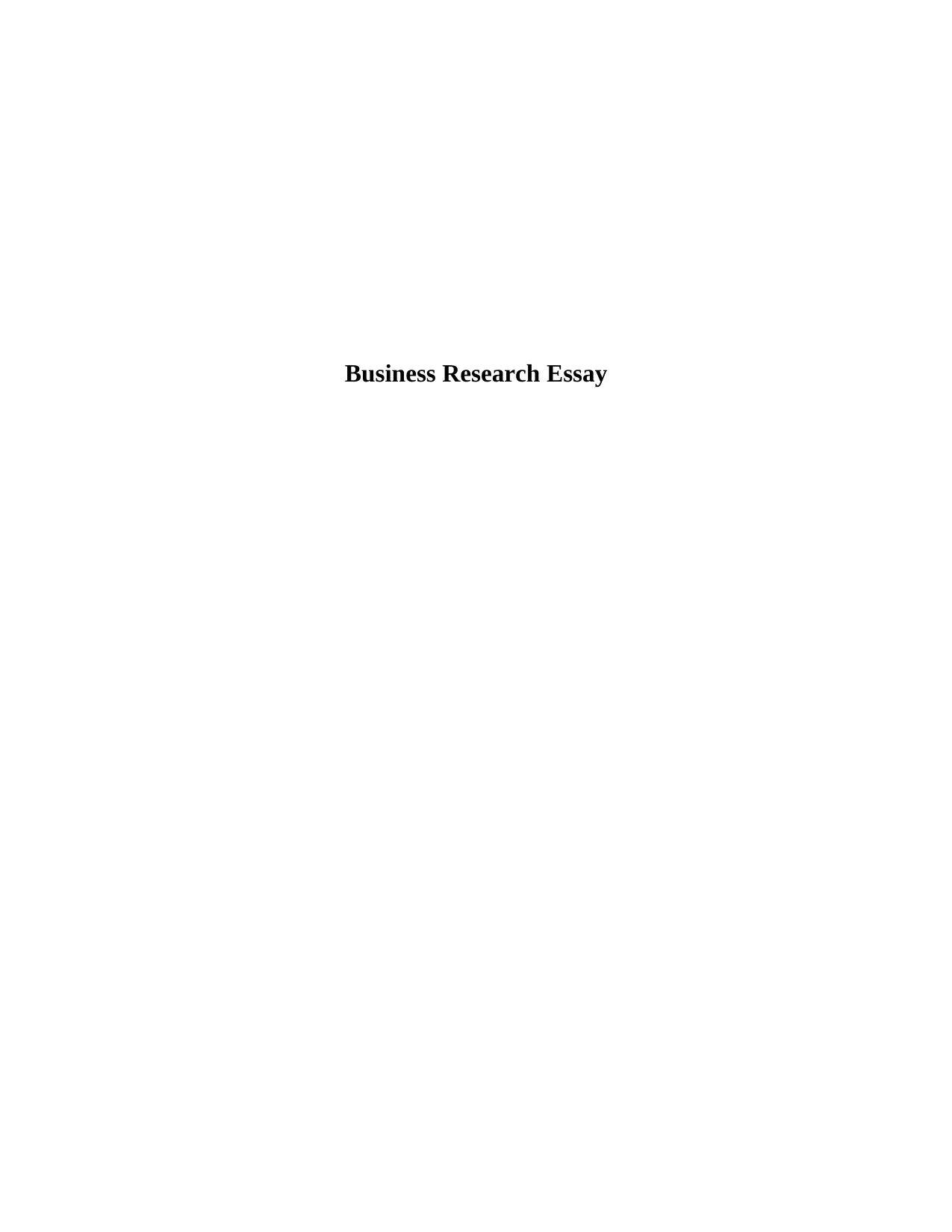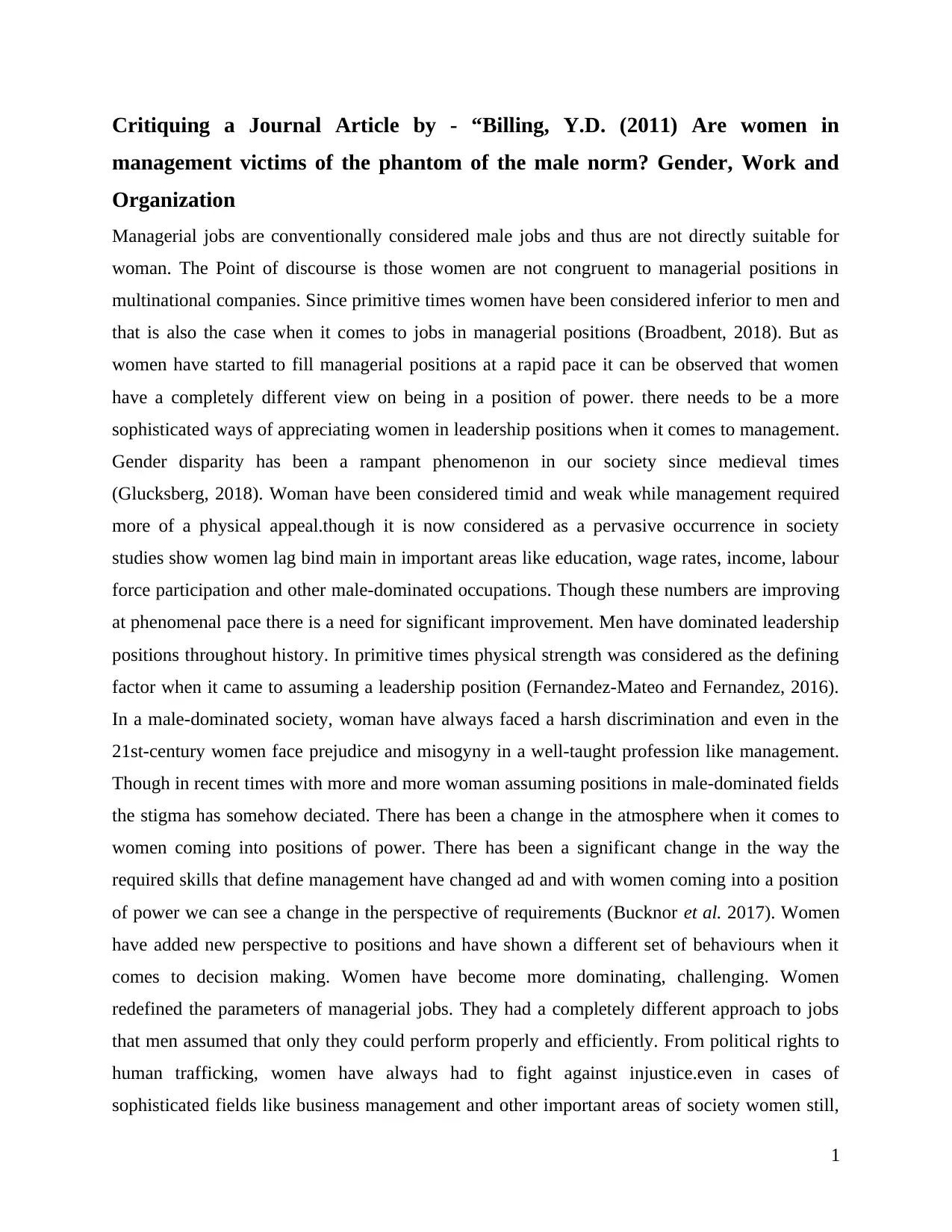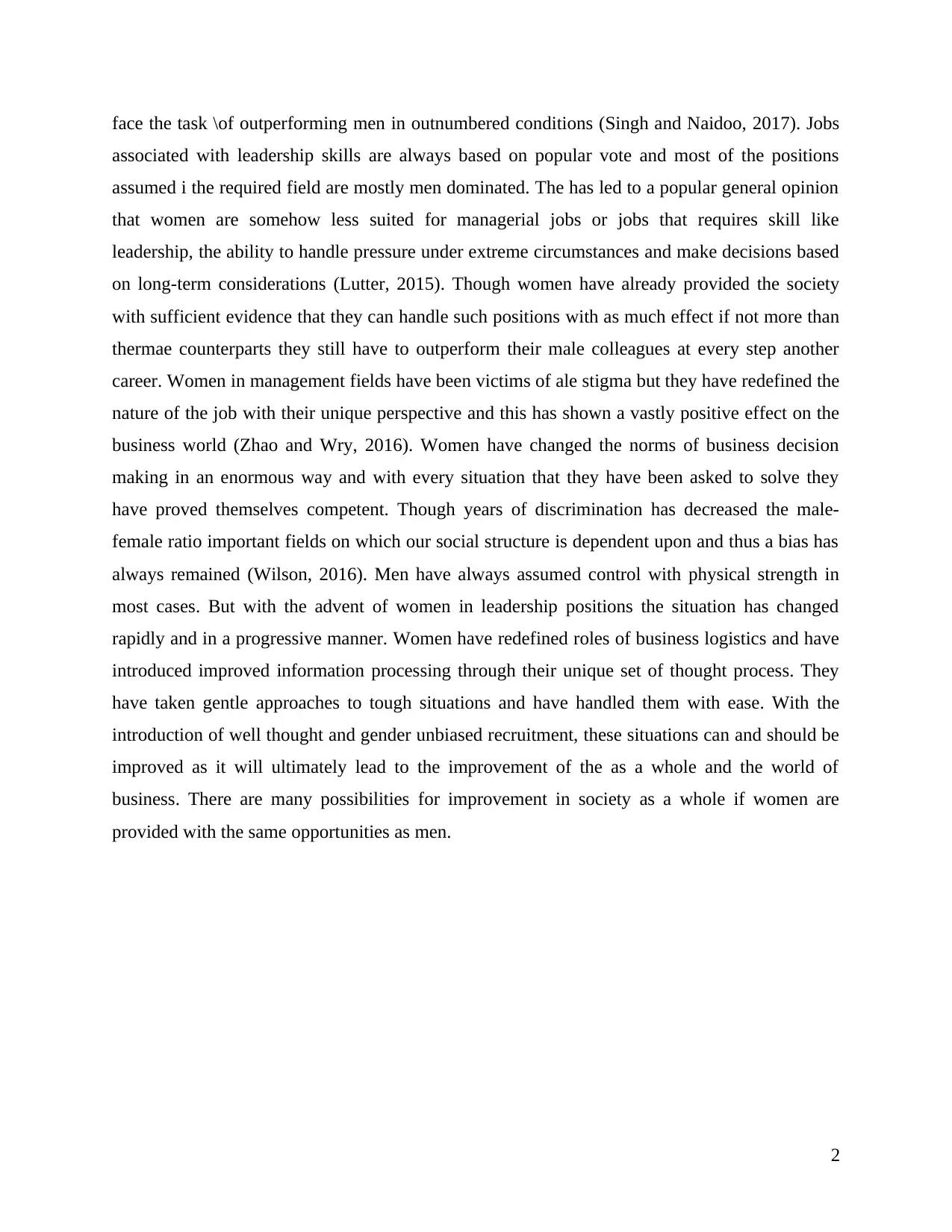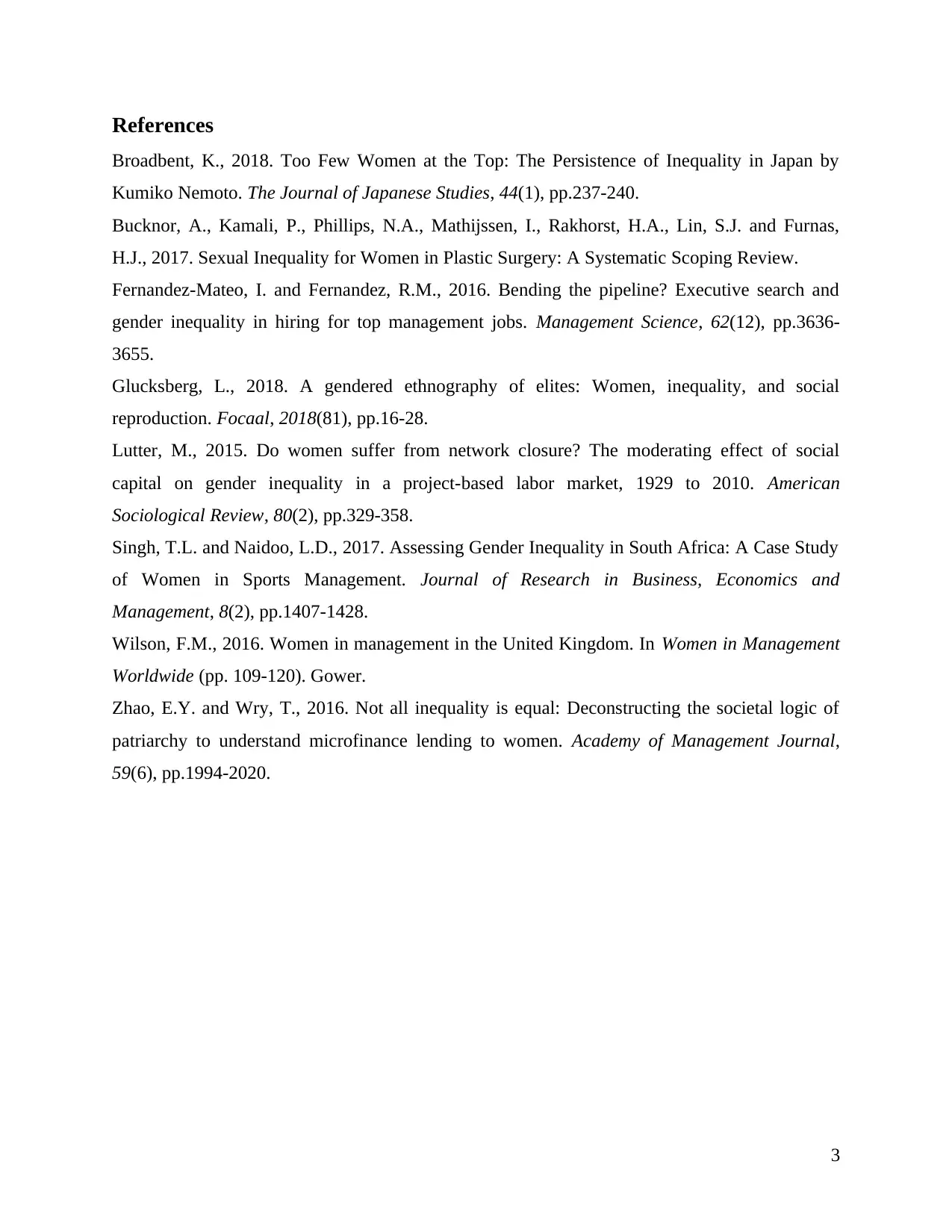Business Research Essay: Critique of Billing (2011) Article on Women
VerifiedAdded on 2023/05/31
|4
|1139
|441
Essay
AI Summary
This essay provides a critical analysis of the journal article by Billing (2011), which explores the challenges faced by women in management, particularly the 'phantom of the male norm'. The essay delves into the background and context of the study, examining the historical and societal factors contributing to gender disparity in leadership positions. It discusses the evolution of managerial roles, the changing perceptions of required skills, and the impact of women's unique perspectives on business decision-making. The critique highlights the ongoing discrimination and bias women face in the workplace while acknowledging their significant contributions and the positive changes they have brought to the business world. The essay references supporting literature to justify its arguments and conclusions, emphasizing the need for gender-unbiased recruitment and equal opportunities to improve society and the world of business.

Business Research Essay
Paraphrase This Document
Need a fresh take? Get an instant paraphrase of this document with our AI Paraphraser

Critiquing a Journal Article by - “Billing, Y.D. (2011) Are women in
management victims of the phantom of the male norm? Gender, Work and
Organization
Managerial jobs are conventionally considered male jobs and thus are not directly suitable for
woman. The Point of discourse is those women are not congruent to managerial positions in
multinational companies. Since primitive times women have been considered inferior to men and
that is also the case when it comes to jobs in managerial positions (Broadbent, 2018). But as
women have started to fill managerial positions at a rapid pace it can be observed that women
have a completely different view on being in a position of power. there needs to be a more
sophisticated ways of appreciating women in leadership positions when it comes to management.
Gender disparity has been a rampant phenomenon in our society since medieval times
(Glucksberg, 2018). Woman have been considered timid and weak while management required
more of a physical appeal.though it is now considered as a pervasive occurrence in society
studies show women lag bind main in important areas like education, wage rates, income, labour
force participation and other male-dominated occupations. Though these numbers are improving
at phenomenal pace there is a need for significant improvement. Men have dominated leadership
positions throughout history. In primitive times physical strength was considered as the defining
factor when it came to assuming a leadership position (Fernandez-Mateo and Fernandez, 2016).
In a male-dominated society, woman have always faced a harsh discrimination and even in the
21st-century women face prejudice and misogyny in a well-taught profession like management.
Though in recent times with more and more woman assuming positions in male-dominated fields
the stigma has somehow deciated. There has been a change in the atmosphere when it comes to
women coming into positions of power. There has been a significant change in the way the
required skills that define management have changed ad and with women coming into a position
of power we can see a change in the perspective of requirements (Bucknor et al. 2017). Women
have added new perspective to positions and have shown a different set of behaviours when it
comes to decision making. Women have become more dominating, challenging. Women
redefined the parameters of managerial jobs. They had a completely different approach to jobs
that men assumed that only they could perform properly and efficiently. From political rights to
human trafficking, women have always had to fight against injustice.even in cases of
sophisticated fields like business management and other important areas of society women still,
1
management victims of the phantom of the male norm? Gender, Work and
Organization
Managerial jobs are conventionally considered male jobs and thus are not directly suitable for
woman. The Point of discourse is those women are not congruent to managerial positions in
multinational companies. Since primitive times women have been considered inferior to men and
that is also the case when it comes to jobs in managerial positions (Broadbent, 2018). But as
women have started to fill managerial positions at a rapid pace it can be observed that women
have a completely different view on being in a position of power. there needs to be a more
sophisticated ways of appreciating women in leadership positions when it comes to management.
Gender disparity has been a rampant phenomenon in our society since medieval times
(Glucksberg, 2018). Woman have been considered timid and weak while management required
more of a physical appeal.though it is now considered as a pervasive occurrence in society
studies show women lag bind main in important areas like education, wage rates, income, labour
force participation and other male-dominated occupations. Though these numbers are improving
at phenomenal pace there is a need for significant improvement. Men have dominated leadership
positions throughout history. In primitive times physical strength was considered as the defining
factor when it came to assuming a leadership position (Fernandez-Mateo and Fernandez, 2016).
In a male-dominated society, woman have always faced a harsh discrimination and even in the
21st-century women face prejudice and misogyny in a well-taught profession like management.
Though in recent times with more and more woman assuming positions in male-dominated fields
the stigma has somehow deciated. There has been a change in the atmosphere when it comes to
women coming into positions of power. There has been a significant change in the way the
required skills that define management have changed ad and with women coming into a position
of power we can see a change in the perspective of requirements (Bucknor et al. 2017). Women
have added new perspective to positions and have shown a different set of behaviours when it
comes to decision making. Women have become more dominating, challenging. Women
redefined the parameters of managerial jobs. They had a completely different approach to jobs
that men assumed that only they could perform properly and efficiently. From political rights to
human trafficking, women have always had to fight against injustice.even in cases of
sophisticated fields like business management and other important areas of society women still,
1

face the task \of outperforming men in outnumbered conditions (Singh and Naidoo, 2017). Jobs
associated with leadership skills are always based on popular vote and most of the positions
assumed i the required field are mostly men dominated. The has led to a popular general opinion
that women are somehow less suited for managerial jobs or jobs that requires skill like
leadership, the ability to handle pressure under extreme circumstances and make decisions based
on long-term considerations (Lutter, 2015). Though women have already provided the society
with sufficient evidence that they can handle such positions with as much effect if not more than
thermae counterparts they still have to outperform their male colleagues at every step another
career. Women in management fields have been victims of ale stigma but they have redefined the
nature of the job with their unique perspective and this has shown a vastly positive effect on the
business world (Zhao and Wry, 2016). Women have changed the norms of business decision
making in an enormous way and with every situation that they have been asked to solve they
have proved themselves competent. Though years of discrimination has decreased the male-
female ratio important fields on which our social structure is dependent upon and thus a bias has
always remained (Wilson, 2016). Men have always assumed control with physical strength in
most cases. But with the advent of women in leadership positions the situation has changed
rapidly and in a progressive manner. Women have redefined roles of business logistics and have
introduced improved information processing through their unique set of thought process. They
have taken gentle approaches to tough situations and have handled them with ease. With the
introduction of well thought and gender unbiased recruitment, these situations can and should be
improved as it will ultimately lead to the improvement of the as a whole and the world of
business. There are many possibilities for improvement in society as a whole if women are
provided with the same opportunities as men.
2
associated with leadership skills are always based on popular vote and most of the positions
assumed i the required field are mostly men dominated. The has led to a popular general opinion
that women are somehow less suited for managerial jobs or jobs that requires skill like
leadership, the ability to handle pressure under extreme circumstances and make decisions based
on long-term considerations (Lutter, 2015). Though women have already provided the society
with sufficient evidence that they can handle such positions with as much effect if not more than
thermae counterparts they still have to outperform their male colleagues at every step another
career. Women in management fields have been victims of ale stigma but they have redefined the
nature of the job with their unique perspective and this has shown a vastly positive effect on the
business world (Zhao and Wry, 2016). Women have changed the norms of business decision
making in an enormous way and with every situation that they have been asked to solve they
have proved themselves competent. Though years of discrimination has decreased the male-
female ratio important fields on which our social structure is dependent upon and thus a bias has
always remained (Wilson, 2016). Men have always assumed control with physical strength in
most cases. But with the advent of women in leadership positions the situation has changed
rapidly and in a progressive manner. Women have redefined roles of business logistics and have
introduced improved information processing through their unique set of thought process. They
have taken gentle approaches to tough situations and have handled them with ease. With the
introduction of well thought and gender unbiased recruitment, these situations can and should be
improved as it will ultimately lead to the improvement of the as a whole and the world of
business. There are many possibilities for improvement in society as a whole if women are
provided with the same opportunities as men.
2
⊘ This is a preview!⊘
Do you want full access?
Subscribe today to unlock all pages.

Trusted by 1+ million students worldwide

References
Broadbent, K., 2018. Too Few Women at the Top: The Persistence of Inequality in Japan by
Kumiko Nemoto. The Journal of Japanese Studies, 44(1), pp.237-240.
Bucknor, A., Kamali, P., Phillips, N.A., Mathijssen, I., Rakhorst, H.A., Lin, S.J. and Furnas,
H.J., 2017. Sexual Inequality for Women in Plastic Surgery: A Systematic Scoping Review.
Fernandez-Mateo, I. and Fernandez, R.M., 2016. Bending the pipeline? Executive search and
gender inequality in hiring for top management jobs. Management Science, 62(12), pp.3636-
3655.
Glucksberg, L., 2018. A gendered ethnography of elites: Women, inequality, and social
reproduction. Focaal, 2018(81), pp.16-28.
Lutter, M., 2015. Do women suffer from network closure? The moderating effect of social
capital on gender inequality in a project-based labor market, 1929 to 2010. American
Sociological Review, 80(2), pp.329-358.
Singh, T.L. and Naidoo, L.D., 2017. Assessing Gender Inequality in South Africa: A Case Study
of Women in Sports Management. Journal of Research in Business, Economics and
Management, 8(2), pp.1407-1428.
Wilson, F.M., 2016. Women in management in the United Kingdom. In Women in Management
Worldwide (pp. 109-120). Gower.
Zhao, E.Y. and Wry, T., 2016. Not all inequality is equal: Deconstructing the societal logic of
patriarchy to understand microfinance lending to women. Academy of Management Journal,
59(6), pp.1994-2020.
3
Broadbent, K., 2018. Too Few Women at the Top: The Persistence of Inequality in Japan by
Kumiko Nemoto. The Journal of Japanese Studies, 44(1), pp.237-240.
Bucknor, A., Kamali, P., Phillips, N.A., Mathijssen, I., Rakhorst, H.A., Lin, S.J. and Furnas,
H.J., 2017. Sexual Inequality for Women in Plastic Surgery: A Systematic Scoping Review.
Fernandez-Mateo, I. and Fernandez, R.M., 2016. Bending the pipeline? Executive search and
gender inequality in hiring for top management jobs. Management Science, 62(12), pp.3636-
3655.
Glucksberg, L., 2018. A gendered ethnography of elites: Women, inequality, and social
reproduction. Focaal, 2018(81), pp.16-28.
Lutter, M., 2015. Do women suffer from network closure? The moderating effect of social
capital on gender inequality in a project-based labor market, 1929 to 2010. American
Sociological Review, 80(2), pp.329-358.
Singh, T.L. and Naidoo, L.D., 2017. Assessing Gender Inequality in South Africa: A Case Study
of Women in Sports Management. Journal of Research in Business, Economics and
Management, 8(2), pp.1407-1428.
Wilson, F.M., 2016. Women in management in the United Kingdom. In Women in Management
Worldwide (pp. 109-120). Gower.
Zhao, E.Y. and Wry, T., 2016. Not all inequality is equal: Deconstructing the societal logic of
patriarchy to understand microfinance lending to women. Academy of Management Journal,
59(6), pp.1994-2020.
3
1 out of 4
Related Documents
Your All-in-One AI-Powered Toolkit for Academic Success.
+13062052269
info@desklib.com
Available 24*7 on WhatsApp / Email
![[object Object]](/_next/static/media/star-bottom.7253800d.svg)
Unlock your academic potential
Copyright © 2020–2025 A2Z Services. All Rights Reserved. Developed and managed by ZUCOL.





